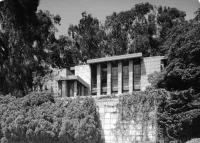Share what you know,
and discover more.
Share what you know,
and discover more.
Sep 28, 1971

-

- Charmaine Bantugan
Storer House - National Register of Historic Places
Statement of Significance One of the four textile block houses designed by Frank Lloyd Wright for Southern California and unique in Wright's conceived them as expressions of the semi-arid climate of Southern California and built them of a material (concrete block) resembling superficially the adobe block of the indigenous house of the region. The houses come out of that Wright period characterized by surface and applied ornament, beginning with the 1914 Midway Gardens, Chicago, and lasting, roughly, through the textile block houses of Southern California. The concrete block of each house was cast in a different design, drawn from nature, and as a whole the houses represent a variation on a structural theme which offers an insight into the creative process of America's foremost genius in the field of architecture. Wright speaks in his autobiography of lifting a gutter material to a place of dignity, which interested him as much/as taking material from "underfoot" in Japan (lava) for the walls of the Imperial Hotel, Tokyo, 1916-1922. There was a. Mayan influence in Wright's Barnsdall house, Los Angeles, 191^1922, and the four textile block houses, shown in the use of in sloping walls and the character of the ornament. The overall textile effect of the block houses is similar to the Baroque period of Maya architecture in which repeated patterns cover entire walls (Palace of Masks).
Storer House - National Register of Historic Places
Statement of Significance One of the four textile block houses designed by Frank Lloyd Wright for Southern California and unique in Wright's conceived them as expressions of the semi-arid climate of Southern California and built them of a material (concrete block) resembling superficially the adobe block of the indigenous house of the region. The houses come out of that Wright period characterized by surface and applied ornament, beginning with the 1914 Midway Gardens, Chicago, and lasting, roughly, through the textile block houses of Southern California. The concrete block of each house was cast in a different design, drawn from nature, and as a whole the houses represent a variation on a structural theme which offers an insight into the creative process of America's foremost genius in the field of architecture. Wright speaks in his autobiography of lifting a gutter material to a place of dignity, which interested him as much/as taking material from "underfoot" in Japan (lava) for the walls of the Imperial Hotel, Tokyo, 1916-1922. There was a. Mayan influence in Wright's Barnsdall house, Los Angeles, 191^1922, and the four textile block houses, shown in the use of in sloping walls and the character of the ornament. The overall textile effect of the block houses is similar to the Baroque period of Maya architecture in which repeated patterns cover entire walls (Palace of Masks).
Sep 28, 1971
Storer House - National Register of Historic Places
Statement of SignificanceOne of the four textile block houses designed by Frank Lloyd Wright for Southern California and unique in Wright's conceived them as expressions of the semi-arid climate of Southern California and built them of a material (concrete block) resembling superficially the adobe block of the indigenous house of the region.
The houses come out of that Wright period characterized by surface and applied ornament, beginning with the 1914 Midway Gardens, Chicago, and lasting, roughly, through the textile block houses of Southern California.
The concrete block of each house was cast in a different design, drawn from nature, and as a whole the houses represent a variation on a structural theme which offers an insight into the creative process of America's foremost genius in the field of architecture.
Wright speaks in his autobiography of lifting a gutter material to a place of dignity, which interested him as much/as taking material from "underfoot" in Japan (lava) for the walls of the Imperial Hotel, Tokyo, 1916-1922.
There was a. Mayan influence in Wright's Barnsdall house, Los Angeles, 191^1922, and the four textile block houses, shown in the use of in sloping walls and the character of the ornament. The overall textile effect of the block houses is similar to the Baroque period of Maya architecture in which repeated patterns cover entire walls (Palace of Masks).
Posted Date
Mar 22, 2022
Historical Record Date
Sep 28, 1971
Source Name
United States Department of Interior - National Park Service
Source Website
Delete Story
Are you sure you want to delete this story?










